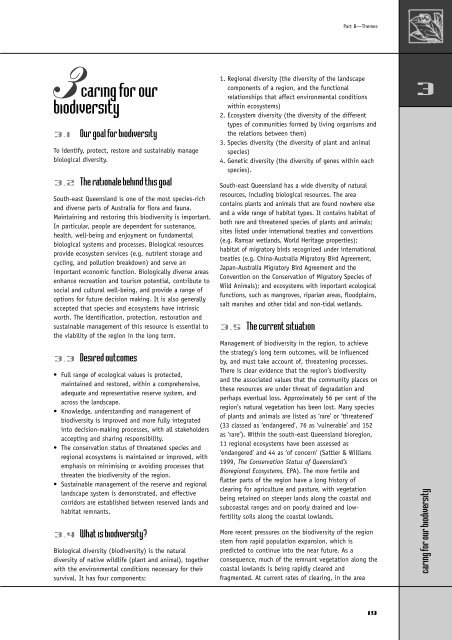December 2000 Version SEQ Natural Resource Management ...
December 2000 Version SEQ Natural Resource Management ...
December 2000 Version SEQ Natural Resource Management ...
You also want an ePaper? Increase the reach of your titles
YUMPU automatically turns print PDFs into web optimized ePapers that Google loves.
Part B—Themes31.caring for ourbiodiversity3.1 Our goal for biodiversityTo identify, protect, restore and sustainably managebiological diversity.3.2 The rationale behind this goalSouth-east Queensland is one of the most species-richand diverse parts of Australia for flora and fauna.Maintaining and restoring this biodiversity is important.In particular, people are dependent for sustenance,health, well-being and enjoyment on fundamentalbiological systems and processes. Biological resourcesprovide ecosystem services (e.g. nutrient storage andcycling, and pollution breakdown) and serve animportant economic function. Biologically diverse areasenhance recreation and tourism potential, contribute tosocial and cultural well-being, and provide a range ofoptions for future decision making. It is also generallyaccepted that species and ecosystems have intrinsicworth. The identification, protection, restoration andsustainable management of this resource is essential tothe viability of the region in the long term.3.3 Desired outcomes• Full range of ecological values is protected,maintained and restored, within a comprehensive,adequate and representative reserve system, andacross the landscape.• Knowledge, understanding and management ofbiodiversity is improved and more fully integratedinto decision-making processes, with all stakeholdersaccepting and sharing responsibility.• The conservation status of threatened species andregional ecosystems is maintained or improved, withemphasis on minimising or avoiding processes thatthreaten the biodiversity of the region.• Sustainable management of the reserve and regionallandscape system is demonstrated, and effectivecorridors are established between reserved lands andhabitat remnants.3.4 What is biodiversity?Biological diversity (biodiversity) is the naturaldiversity of native wildlife (plant and animal), togetherwith the environmental conditions necessary for theirsurvival. It has four components:Regional diversity (the diversity of the landscapecomponents of a region, and the functionalrelationships that affect environmental conditionswithin ecosystems)2. Ecosystem diversity (the diversity of the differenttypes of communities formed by living organisms andthe relations between them)3. Species diversity (the diversity of plant and animalspecies)4. Genetic diversity (the diversity of genes within eachspecies).South-east Queensland has a wide diversity of naturalresources, including biological resources. The areacontains plants and animals that are found nowhere elseand a wide range of habitat types. It contains habitat ofboth rare and threatened species of plants and animals;sites listed under international treaties and conventions(e.g. Ramsar wetlands, World Heritage properties);habitat of migratory birds recognized under internationaltreaties (e.g. China-Australia Migratory Bird Agreement,Japan-Australia Migratory Bird Agreement and theConvention on the Conservation of Migratory Species ofWild Animals); and ecosystems with important ecologicalfunctions, such as mangroves, riparian areas, floodplains,salt marshes and other tidal and non-tidal wetlands.3.5 The current situation<strong>Management</strong> of biodiversity in the region, to achievethe strategy’s long term outcomes, will be influencedby, and must take account of, threatening processes.There is clear evidence that the region’s biodiversityand the associated values that the community places onthese resources are under threat of degradation andperhaps eventual loss. Approximately 56 per cent of theregion’s natural vegetation has been lost. Many speciesof plants and animals are listed as ‘rare’ or ‘threatened’(33 classed as ‘endangered’, 76 as ‘vulnerable’ and 152as ‘rare’). Within the south-east Queensland bioregion,11 regional ecosystems have been assessed as‘endangered’ and 44 as ‘of concern’ (Sattler & Williams1999, The Conservation Status of Queensland’sBioregional Ecosystems, EPA). The more fertile andflatter parts of the region have a long history ofclearing for agriculture and pasture, with vegetationbeing retained on steeper lands along the coastal andsubcoastal ranges and on poorly drained and lowfertilitysoils along the coastal lowlands.More recent pressures on the biodiversity of the regionstem from rapid population expansion, which ispredicted to continue into the near future. As aconsequence, much of the remnant vegetation along thecoastal lowlands is being rapidly cleared andfragmented. At current rates of clearing, in the area193caring for our biodiversity


